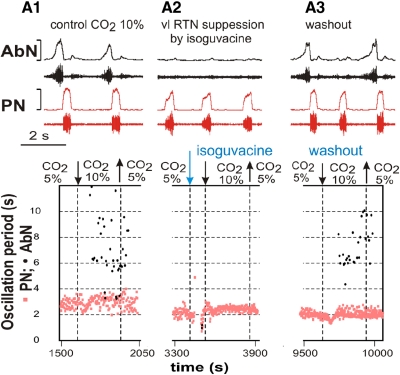Fig. 2.
The effect of retrotrapezoid nucleus/parafacial respiratory group (RTN/pFRG) suppression on hypercapnia-evoked late-E abdominal activity. The ventrolateral (vl) RTN/pFRG region was inactivated by local bilateral microinjection of isoguvacine, a GABAA receptor agonist. A, 1–3: 3 epochs from the same experiment. In each column, the top diagram shows the raw recording and integrated activity of PN (bottom traces, red) and AbN (top traces, black) nerves, and the bottom diagram shows the changes in the oscillation periods in the PN and AbN with time. In A1, hypercapnia (10% CO2) evoked quantally dispersed late-E bursts in AbN (see nerve recordings at the top and black circles in the bottom diagram). Note that the time interval was not sufficient to allow development of 1:1 ratio of AbN:PN frequencies. In A2, injection of isoguacine fully blocked late-E AbN bursting that would be expected at 10% CO2 (no black circles). In A3, hypercapnia (10% CO2) again evoked late-E discharges in AbN discharge after isoguvacine washout.

